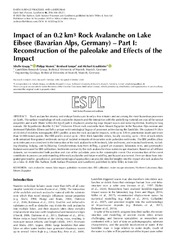Impact of an 0.2 km3 Rock Avalanche on Lake Eibsee (Bavarian Alps, Germany) – Part I: Reconstruction of the paleolake and Effects of the Impact
Knapp, Sibylle; Mamot, Philipp; Lempe, Bernhard; Krautblatter, Michael, 2020: Impact of an 0.2 km3 Rock Avalanche on Lake Eibsee (Bavarian Alps, Germany) – Part I: Reconstruction of the paleolake and Effects of the Impact. In: Earth Surface Processes and Landforms, Band 46, 1: 296 - 306, DOI: 10.23689/fidgeo-4069.
 |
Dokument öffnen: |
Rock avalanches destroy and reshape landscapes in only a few minutes and are among the most hazardous processes on Earth. The surface morphology of rock avalanche deposits and the interaction with the underlying material are crucial for runout properties and reach. Water within the travel path is displaced, producing large impact waves and reducing friction, leading to long runouts. We hypothesize that the 0.2 km3 Holocene Eibsee rock avalanche from Mount Zugspitze in the Bavarian Alps overran and destroyed Paleolake Eibsee and left a unique sedimentological legacy of processes active during the landslide. We captured 9.5 km of electrical resistivity tomography (ERT) profiles across the rock avalanche deposits, with up to 120 m penetration depth and more than 34 000 datum points. The ERT profiles reveal up to ~50 m thick landslide debris, locally covering up to ~30 m of rock debris with entrained fine‐grained sediments on top of isolated remnants of decametre‐wide paleolake sediments. The ERT profiles allow us to infer processes involved in the interaction of the rock avalanche with bedrock, lake sediments, and morainal sediments, including shearing, bulging, and bulldozing. Complementary data from drilling, a gravel pit exposure, laboratory tests, and geomorphic features were used for ERT calibration. Sediments overrun by the rock avalanche show water‐escape structures. Based on all of these datasets, we reconstructed both position and size of the paleolake prior to the catastrophic event. Our reconstruction of the event contributes to process an understanding of the rock avalanche and future modelling and hazard assessment. Here we show how integrated geomorphic, geophysical, and sedimentological approaches can provide detailed insights into the impact of a rock avalanche on a lake. © 2020 The Authors. Earth Surface Processes and Landforms published by John Wiley & Sons Ltd The Eibsee rock avalanche detached from Mount Zugspitze and impacted and destroyed Paleolake Eibsee. Paleolake Eibsee was larger than modern Lake Eibsee; the rock avalanche deposit covers the northern half of the paleolake. The complementary application of geomorphology, electrical resistivity tomography (ERT) and sedimentology allows for ERT calibration at seven different sites, where materials (rock avalanche, bedrock, lake clay, mixed sediments) and effects of the impact (bulldozing, bulging, overriding of secondary lobes, splashing of boulders) can be distinguished.
Statistik:
ZugriffsstatistikSammlung:
- Geologie [931]
Schlagworte:
rock avalancherunout
lake impact
paleolake reconstruction
ERT calibration
water‐escape structures
Northern Calcareous Alps
Eibsee
Zugspitze
This is an open access article under the terms of the Creative Commons Attribution License, which permits use, distribution and reproduction in any medium, provided the original work is properly cited.

